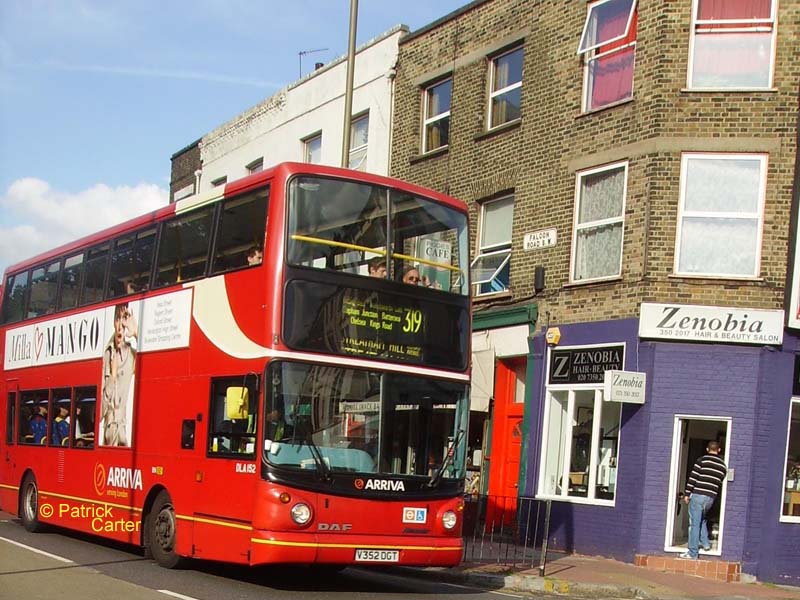 | Photo © Patrick Carter. |
Home | Bus routes | Operational details | Service changes | Operators & Garages | Photo gallery
One of the last of the infamous single deck conversions of trunk routes carried out in the 1990s to remain was the 319, which has now at last reverted to double deck operation. DAF DB250s from Arriva's existing fleet are used, and commenced operations upon contract renewal on 16 September 2006, having been displaced earlier in the year from routes 68 and 468 lost to London Central. At one point the conversion was to have been brought forward, but in the event this did not happen. Here DLA 152 (V352 DGT) passes southwards through the tacky end of Clapham Junction on 13 October 2006.
 | Photo © Patrick Carter. |
Despite its number the 319 is not a former section of route 19, but a former section of route 49, which once ran from Shepherd’s Bush to Crystal Palace taking around 76 minutes. At peak times, it now takes almost as long as that just to get from Shepherd’s Bush to Clapham Junction, the present southern terminus of the 49, increased traffic levels being the cause. From Clapham Junction, the 49 used to run via Wandsworth Common, Tooting Bec, Streatham Common, Upper Norwood to Crystal Palace. This route survived pretty much unchanged until the early 1970s, but was then curtailed to Streatham with a new 249 taking over the section from Crystal Palace as far as Clapham Junction. Oddly, the Clapham Junction leg was renumbered 49 again briefly from 1989 until 1991, although in practice it continued to run in sections with few journeys actually running the full route.
From 9 May 1991, the 49 was unusually split into three separate overlapping routes, the 49 now running from Shepherd’s Bush to Clapham Junction, the 349 covering the route between South Kensington and Streatham garage — from where it was initially run, as the 49 had been — and the 249 from Tooting Bec to Crystal Palace. On Sundays the 249 did not run and the 349 was extended to Crystal Palace to cover. There were some associated changes too, though; route 30, formerly Hackney Wick to West Brompton, now ran no further than Euston, being diverted to Trafalgar Square instead. The 74, which had duplicated the 30 between South Kensington and Baker Street, was diverted to Kings Cross to cover, but this left a short section between South Kensington and West Brompton that had been unique to the 30, and thus the new 349 ran to West Brompton to cover.
Meanwhile, route 219, the former southern leg of route 19, by this time had been running from Mitcham to South Kensington, thus duplicating the 49 between Clapham Junction and South Kensington. The 19 was cut back further still to Battersea Bridge, and to retain links from Clapham Junction the 219 was diverted to Sloane Square; introduction of the 349 maintained capacity on the former alignment to South Kensington. This manipulation was to be repeated in 1993.
Closure of Streatham garage in 1992 resulted in the 249 moving to Norwood and the 349 to Brixton, being converted from Metrobus to Titan operation in the process. The Streatham terminus was altered accordingly from Streatham garage to Brixton garage (which is actually on Streatham Hill). In turn, the Sunday service running through from West Brompton to Crystal Palace had to be renumbered from 349 to 249 to avoid a bifurcation. But then, as hinted in the previous paragraph, the 349 was diverted to Sloane Square from 8 February 1993, to enable the 219 to be curtailed to Battersea. It was simultaneously renumbered 319, but the anomaly on Sundays remained with the 249 running through to Sloane Square on this day. The section between South Kensington and West Brompton was covered by a re-vamped C1.
In 1996 the 319 finally gained a Sunday service, but at the price of the section to Streatham Hill, as buses now terminated at St. Leonard’s Church. In addition, the Metrobuses were replaced without any increase to the frequency by standard floor Dennis Darts to 9.8m length. At least these seated 40, but they were replaced in 1998 by the some of the first low floor Darts, seating only 25 — and still without any increase in frequency compared to the 71 seat Metrobuses! This was part of a mid-contract upgrade which also fulfilled passenger requests to restore the link to Streatham Hill, albeit restricted to 9 AM to 7 PM on Mondays to Saturdays only.
The last new contract starting on 15 September 2001 brought in some genuine improvements, with a higher frequency, daily operation to Streatham Hill and better buses, in the shape of the first allocation of DAF SB120/Wright Cadet buses in London. These vehicles were actually quite similar to Darts in technological terms, although wider and with more seats. The re-specification of single deckers was quite surprising as the tide was already beginning to turn in favour once again of double deckers on routes of this kind. That conversion has now at last come about, and has been presented as part of the package of bus improvements to serve the western extension of the Congestion Charge zone, although in reality was mooted several years ago and would almost certainly have happened anyway.
Navigation
| Previous | Next | |
| Chronologically | 405 | 353 |
| Numerically | 315 | 320 |
Photo Gallery | Bus route list | Operational details | Service changes | Operators & Garages